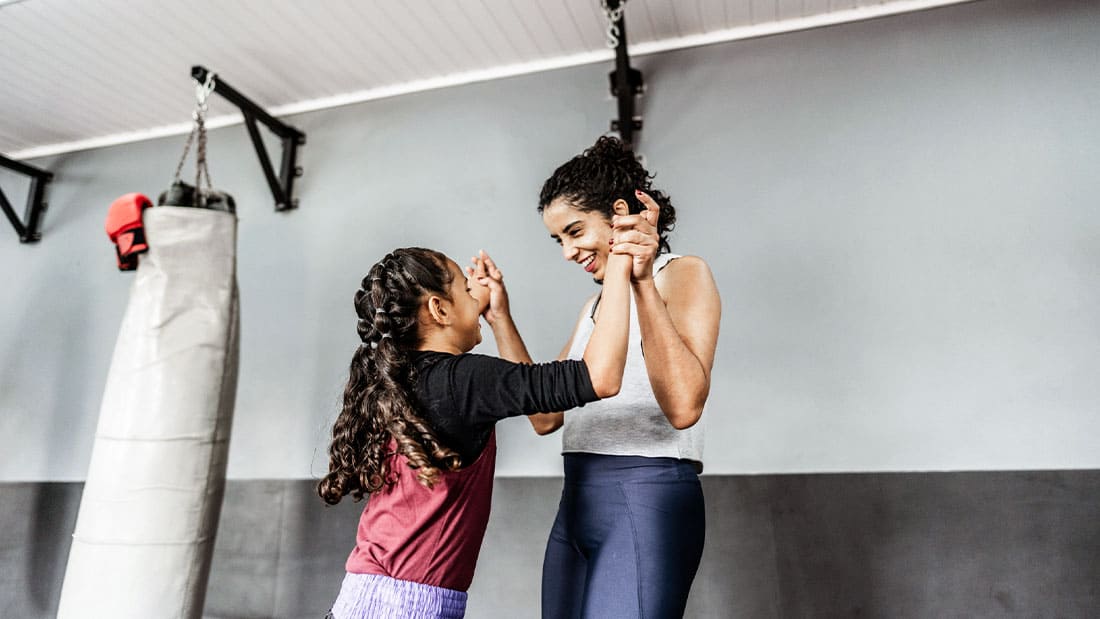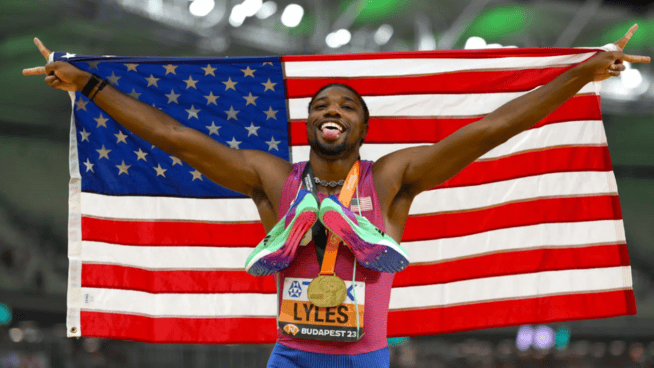Control the trenches.
That might sound like a battle plan from World War I, but it’s also the key to winning football games. We saw it during the Denver Broncos’ sack-filled run to becoming Super Bowl 50 champions. If you control the line of scrimmage, you control the game.
For players who make their living on or near the line of scrimmage, the ability to control the line often comes down to hand combat.
Hand combat is the art of creating leverage with strategic hand placement. The hand-to-hand warfare that occurs around the line of scrimmage isn’t so different from combat sports like Mixed Martial Arts, which is exactly why many NFL players are using that type of training to gain an edge. Elite pass rushers, in particular, are finding extraordinary benefits in combat sport training, allowing them to terrorize quarterbacks like never before.
The Karate Coach

Joe Kim during his time with the Redskins
Though position coaches remain a standard fixture in the NFL, they’ve been supplemented by combat sport specialists.
In addition to a number of private trainers who work with players in the off-season, the Cleveland Browns, New England Patriots, Kansas City Chiefs, Washington Redskins and Chicago Bears have in recent years employed combat sport specialists.
So, where did this trend began?
It’s hard to know for sure, but Lawrence Taylor and Andre Tippett might be the genesis. They were premiere pass rushers in the 1980s, and both used martial arts in their training. Bill Belichick was the New York Giants defensive coordinator from 1985 to 1990, so he saw Taylor’s dominance every day. In Belichick’s mind, Taylor’s martial arts training was his secret weapon.
Shortly after he accepted a head coaching position with the Cleveland Browns in 1991, Belichick hired Joe Kim as an assistant strength coach. Belichick wasn’t interested in his weight room expertise, though; at the time, Kim was a fourth-degree black belt and a member of the United States National Taekwondo team. Kim worked extensively with the team’s pass rushers, helping defensive end Anthony Pleasant go from 4 sacks in 1992 to 11 in 1993.
RELATED: The Cleveland Browns Have Hired a Martial Arts Expert as a Strength and Conditioning Coach
In a 2008 press conference, Belichick said, “When I got to Cleveland, I hired a martial arts instructor and he worked with the team. Anthony Pleasant was a big proponent of that and it really helped him. As it turned out, it didn’t only help with the hand quickness and defensive attacking moves but also the flexibility training that the martial arts people use.”
Kim’s success in Cleveland caught the attention of other teams. After the Cleveland franchise left for Baltimore in 1995, Kim (who is now back with the Browns) spent time in Dallas, Miami, Green Bay, Denver, Buffalo, Kansas City, Chicago and Washington.
[youtube video=”B8-v-8yKpCY”]Kim helped pioneer the use of martial arts training in the NFL, and others followed his lead. Jay Glazer, whom you probably recognize from his gig as a FOX Sports NFL insider, is one of them. Glazer, who has a strong MMA background, trained Jared Allen in mixed martial arts during the 2007 off-season. The next season, Allen posted a career-high 15.5 sacks and was named to his first Pro Bowl. Glazer had long suspected that MMA-style training could make superior football players, and Allen’s performance proved it. Now, Glazer’s Unbreakable Performance Center in West Hollywood is filled with NFL players looking to mix it up with MMA.
RELATED: Dashon Goldson’s MMA Workouts with Jay Glazer
Valentin Espiricueta is a skilled muay Thai practitioner and the owner of AppliedMMA in Dallas. He’s the man DeMarcus Ware credits with helping him amass 134.5 career sacks. Ben Creamer, a Hand Combat Coach at Ignition APG in Cincinnati, is another expert in the field. According to Ignition’s website, Creamer “implements principles of Kung Fu, boxing, judo and ju-jitsu in a specific way to NFL athletes.” He’s worked with the likes of Carlos Dunlap, Connor Barwin and Luke Kuechly.
Live look: Hand combat training with @ben_creamer_ at @IgnitionAPG. #NFL #Bears #Bengals #49ers #Chiefs pic.twitter.com/lpbnVIbLkd
— Clif Marshall (@ClifMarshall) June 27, 2016
Fighting Harder and Smarter

DeMarcus Ware demonstrating a hand combat technique
The business of MMA-style training catering to NFL players is bigger than ever. But why are combat sports such an effective form of cross-training for these players?
It’s not like there’s some secret karate move that results in an instant sack (though if we ever find one, we’ll be sure to write about it). In reality, the benefits often boil down to refined technique, enhanced knowledge and a hardened mentality.
Combat sport training teaches players how to make the most out of each movement. Against elite competition, you cannot rely purely on brute power or raw speed. A 320-pound left tackle isn’t going to budge if you don’t attack him the right way. “I found early on that you don’t have to be the biggest or strongest player,” Glazer told STACK. “It’s all about your technique and explosive power.”
RELATED: Jared Allen’s Five Moves For Rushing The Passer
Combat training teaches players the best way to deliver and counter strikes while also enhancing their hand speed and hand-eye coordination. The endless repetition used in combat sport “sparring” helps make these movements second nature, giving players the tools to win one-on-one battles. “[MMA training] completely changed my game and hand-eye coordination. As a defensive lineman, you’re constantly having a hand battle with your opponent. So just getting that hand-eye coordination and knowing where you are in space and upping your awareness, it takes your game to another level. That’s really what it is, it’s a giant hand battle. If you have the advantage in that, you have a higher chance of winning the rep,” Detroit Lions rookie Anthony Zettel told STACK in an interview. Zettel began including MMA in his training routine while he was at Penn State.
[youtube video=”ID_A06XtgD0″]RELATED: Athletic Freak Anthony Zettel is Ready to Dominate the NFL
Not only do players learn how to make their movements quicker and more violent, they also learn techniques for creating leverage. One example comes from Ryan Hoover, a Krav Maga Force Training instructor and a co-founder of the Fit To Fight program, which is used by the Carolina Panthers.
Hoover preaches something called “The Elbow Rule,” which states that “as long as you are inside your opponent’s elbows, you’re inside of his power.” He teaches players to create angles that allow them to get outside their opponent’s elbows while keeping their own elbows inside. Ware offered a similar sentiment in his interview with STACK, saying he always tries to attack one half of his opponent.
RELATED: Hand-Battling With DeMarcus Ware
One thing pass rushers can use to their advantage is the knowledge that offensive linemen must deliver a punch. Where, when and how the punch is delivered differs, but you never see an o-lineman attempt to block a player in pass protection without delivering a punch. Knowing a punch is coming helps pass rushers learn the best way to counteract it, and countering strikes (or at least reducing their effectiveness) is at the heart of combat sport training. “We want you to punch us. I know that we have the skills to defeat that,” Kim told Cleveland.com in a recent interview.
Combat training is also a unique form of conditioning for players. When you think of traditional football conditioning, you probably think of Sideline Gassers or 300-Yard Shuttles. But how often do you actually use that stuff in a game? Combat training allows players to condition with explosive movements and repetitive contact, which is more akin to how many players—linemen, in particular—play the game. If your hands get tired and lazy during crunch time, you won’t be making many plays.
RELATED: Why Football Players Should Use MMA Training
Combat sport training also promotes a unique mentality. MMA is a one-on-one sport that requires a combatant to break down the opponent across from him. Though football is a team sport, the outcome of games is often determined by one-on-one battles. By training with an martial arts mindset alongside actual MMA fighters (which is the case at Glazer’s gym), football players build mental fortitude and an aggressive mindset that can serve them well between the white lines.
Ready to Rumble

Jay Glazer working with Dashon Goldson
Interested in using MMA-style training to step up your game? Awesome. Feel free to look for a combat sport specialist in your area, ideally one who has some background working with football players. In the meantime, you can use this sample MMA workout provided by Hoover:
Warm-up
- Two to three rounds of Jump Rope
- Two to three minutes per round, one minute of rest between rounds
Mitt Work (with a coach)
- Six to eight rounds
- Two to three minutes per round, one minute of rest between rounds
Rounds consist of basic punch combinations, usually less than four punches per combination. Hoover often has clients “double up,” throwing multiple punches from the same side, to work on re-engaging their bodies. Depending on the focus of the day, a coach may also include footwork, head movement, and basic hand fighting. Typically, you want the puncher to end the combination “outside the elbows” of the mitt holder/coach. Some basic combinations include:
- jab/cross/lead hook
- jab/lead hook
- rear uppercut/cross
- rear uppercut/lead hook/cross
- jab/slip a jab/cross
Wrestling
- Two to three rounds
- Two to three minutes per round, one minute of rest between rounds
Basic wrestling examples:
- Pummeling (compliant but with resistance)
- Arm drags
- Hand fighting
- Head clears
The number of rounds, times, and levels of intensity can be adjusted based on the needs of the session/client.
RECOMMENDED FOR YOU
MOST POPULAR
Control the trenches.
That might sound like a battle plan from World War I, but it’s also the key to winning football games. We saw it during the Denver Broncos’ sack-filled run to becoming Super Bowl 50 champions. If you control the line of scrimmage, you control the game.
For players who make their living on or near the line of scrimmage, the ability to control the line often comes down to hand combat.
Hand combat is the art of creating leverage with strategic hand placement. The hand-to-hand warfare that occurs around the line of scrimmage isn’t so different from combat sports like Mixed Martial Arts, which is exactly why many NFL players are using that type of training to gain an edge. Elite pass rushers, in particular, are finding extraordinary benefits in combat sport training, allowing them to terrorize quarterbacks like never before.
The Karate Coach

Joe Kim during his time with the Redskins
Though position coaches remain a standard fixture in the NFL, they’ve been supplemented by combat sport specialists.
In addition to a number of private trainers who work with players in the off-season, the Cleveland Browns, New England Patriots, Kansas City Chiefs, Washington Redskins and Chicago Bears have in recent years employed combat sport specialists.
So, where did this trend began?
It’s hard to know for sure, but Lawrence Taylor and Andre Tippett might be the genesis. They were premiere pass rushers in the 1980s, and both used martial arts in their training. Bill Belichick was the New York Giants defensive coordinator from 1985 to 1990, so he saw Taylor’s dominance every day. In Belichick’s mind, Taylor’s martial arts training was his secret weapon.
Shortly after he accepted a head coaching position with the Cleveland Browns in 1991, Belichick hired Joe Kim as an assistant strength coach. Belichick wasn’t interested in his weight room expertise, though; at the time, Kim was a fourth-degree black belt and a member of the United States National Taekwondo team. Kim worked extensively with the team’s pass rushers, helping defensive end Anthony Pleasant go from 4 sacks in 1992 to 11 in 1993.
RELATED: The Cleveland Browns Have Hired a Martial Arts Expert as a Strength and Conditioning Coach
In a 2008 press conference, Belichick said, “When I got to Cleveland, I hired a martial arts instructor and he worked with the team. Anthony Pleasant was a big proponent of that and it really helped him. As it turned out, it didn’t only help with the hand quickness and defensive attacking moves but also the flexibility training that the martial arts people use.”
Kim’s success in Cleveland caught the attention of other teams. After the Cleveland franchise left for Baltimore in 1995, Kim (who is now back with the Browns) spent time in Dallas, Miami, Green Bay, Denver, Buffalo, Kansas City, Chicago and Washington.
[youtube video=”B8-v-8yKpCY”]Kim helped pioneer the use of martial arts training in the NFL, and others followed his lead. Jay Glazer, whom you probably recognize from his gig as a FOX Sports NFL insider, is one of them. Glazer, who has a strong MMA background, trained Jared Allen in mixed martial arts during the 2007 off-season. The next season, Allen posted a career-high 15.5 sacks and was named to his first Pro Bowl. Glazer had long suspected that MMA-style training could make superior football players, and Allen’s performance proved it. Now, Glazer’s Unbreakable Performance Center in West Hollywood is filled with NFL players looking to mix it up with MMA.
RELATED: Dashon Goldson’s MMA Workouts with Jay Glazer
Valentin Espiricueta is a skilled muay Thai practitioner and the owner of AppliedMMA in Dallas. He’s the man DeMarcus Ware credits with helping him amass 134.5 career sacks. Ben Creamer, a Hand Combat Coach at Ignition APG in Cincinnati, is another expert in the field. According to Ignition’s website, Creamer “implements principles of Kung Fu, boxing, judo and ju-jitsu in a specific way to NFL athletes.” He’s worked with the likes of Carlos Dunlap, Connor Barwin and Luke Kuechly.
Live look: Hand combat training with @ben_creamer_ at @IgnitionAPG. #NFL #Bears #Bengals #49ers #Chiefs pic.twitter.com/lpbnVIbLkd
— Clif Marshall (@ClifMarshall) June 27, 2016
Fighting Harder and Smarter

DeMarcus Ware demonstrating a hand combat technique
The business of MMA-style training catering to NFL players is bigger than ever. But why are combat sports such an effective form of cross-training for these players?
It’s not like there’s some secret karate move that results in an instant sack (though if we ever find one, we’ll be sure to write about it). In reality, the benefits often boil down to refined technique, enhanced knowledge and a hardened mentality.
Combat sport training teaches players how to make the most out of each movement. Against elite competition, you cannot rely purely on brute power or raw speed. A 320-pound left tackle isn’t going to budge if you don’t attack him the right way. “I found early on that you don’t have to be the biggest or strongest player,” Glazer told STACK. “It’s all about your technique and explosive power.”
RELATED: Jared Allen’s Five Moves For Rushing The Passer
Combat training teaches players the best way to deliver and counter strikes while also enhancing their hand speed and hand-eye coordination. The endless repetition used in combat sport “sparring” helps make these movements second nature, giving players the tools to win one-on-one battles. “[MMA training] completely changed my game and hand-eye coordination. As a defensive lineman, you’re constantly having a hand battle with your opponent. So just getting that hand-eye coordination and knowing where you are in space and upping your awareness, it takes your game to another level. That’s really what it is, it’s a giant hand battle. If you have the advantage in that, you have a higher chance of winning the rep,” Detroit Lions rookie Anthony Zettel told STACK in an interview. Zettel began including MMA in his training routine while he was at Penn State.
[youtube video=”ID_A06XtgD0″]RELATED: Athletic Freak Anthony Zettel is Ready to Dominate the NFL
Not only do players learn how to make their movements quicker and more violent, they also learn techniques for creating leverage. One example comes from Ryan Hoover, a Krav Maga Force Training instructor and a co-founder of the Fit To Fight program, which is used by the Carolina Panthers.
Hoover preaches something called “The Elbow Rule,” which states that “as long as you are inside your opponent’s elbows, you’re inside of his power.” He teaches players to create angles that allow them to get outside their opponent’s elbows while keeping their own elbows inside. Ware offered a similar sentiment in his interview with STACK, saying he always tries to attack one half of his opponent.
RELATED: Hand-Battling With DeMarcus Ware
One thing pass rushers can use to their advantage is the knowledge that offensive linemen must deliver a punch. Where, when and how the punch is delivered differs, but you never see an o-lineman attempt to block a player in pass protection without delivering a punch. Knowing a punch is coming helps pass rushers learn the best way to counteract it, and countering strikes (or at least reducing their effectiveness) is at the heart of combat sport training. “We want you to punch us. I know that we have the skills to defeat that,” Kim told Cleveland.com in a recent interview.
Combat training is also a unique form of conditioning for players. When you think of traditional football conditioning, you probably think of Sideline Gassers or 300-Yard Shuttles. But how often do you actually use that stuff in a game? Combat training allows players to condition with explosive movements and repetitive contact, which is more akin to how many players—linemen, in particular—play the game. If your hands get tired and lazy during crunch time, you won’t be making many plays.
RELATED: Why Football Players Should Use MMA Training
Combat sport training also promotes a unique mentality. MMA is a one-on-one sport that requires a combatant to break down the opponent across from him. Though football is a team sport, the outcome of games is often determined by one-on-one battles. By training with an martial arts mindset alongside actual MMA fighters (which is the case at Glazer’s gym), football players build mental fortitude and an aggressive mindset that can serve them well between the white lines.
Ready to Rumble

Jay Glazer working with Dashon Goldson
Interested in using MMA-style training to step up your game? Awesome. Feel free to look for a combat sport specialist in your area, ideally one who has some background working with football players. In the meantime, you can use this sample MMA workout provided by Hoover:
Warm-up
- Two to three rounds of Jump Rope
- Two to three minutes per round, one minute of rest between rounds
Mitt Work (with a coach)
- Six to eight rounds
- Two to three minutes per round, one minute of rest between rounds
Rounds consist of basic punch combinations, usually less than four punches per combination. Hoover often has clients “double up,” throwing multiple punches from the same side, to work on re-engaging their bodies. Depending on the focus of the day, a coach may also include footwork, head movement, and basic hand fighting. Typically, you want the puncher to end the combination “outside the elbows” of the mitt holder/coach. Some basic combinations include:
- jab/cross/lead hook
- jab/lead hook
- rear uppercut/cross
- rear uppercut/lead hook/cross
- jab/slip a jab/cross
Wrestling
- Two to three rounds
- Two to three minutes per round, one minute of rest between rounds
Basic wrestling examples:
- Pummeling (compliant but with resistance)
- Arm drags
- Hand fighting
- Head clears
The number of rounds, times, and levels of intensity can be adjusted based on the needs of the session/client.












